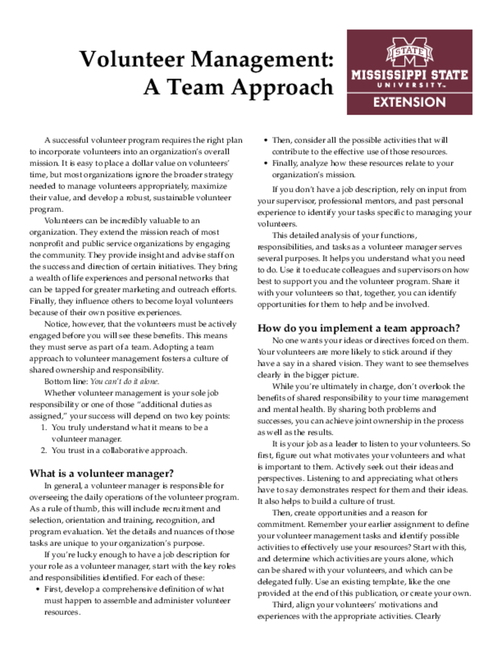Volunteer Management: A Team Approach
A successful volunteer program requires the right plan to incorporate volunteers into an organization’s overall mission. It is easy to place a dollar value on volunteers’ time, but most organizations ignore the broader strategy needed to manage volunteers appropriately, maximize their value, and develop a robust, sustainable volunteer program.
Volunteers can be incredibly valuable to an organization. They extend the mission reach of most nonprofit and public service organizations by engaging the community. They provide insight and advise staff on the success and direction of certain initiatives. They bring a wealth of life experiences and personal networks that can be tapped for greater marketing and outreach efforts. Finally, they influence others to become loyal volunteers because of their own positive experiences.
Notice, however, that the volunteers must be actively engaged before you will see these benefits. This means they must serve as part of a team. Adopting a team approach to volunteer management fosters a culture of shared ownership and responsibility.
Bottom line: You can’t do it alone.
Whether volunteer management is your sole job responsibility or one of those “additional duties as assigned,” your success will depend on two key points:
- You truly understand what it means to be a volunteer manager.
- You trust in a collaborative approach.
What is a volunteer manager?
In general, a volunteer manager is responsible for overseeing the daily operations of the volunteer program. As a rule of thumb, this will include recruitment and selection, orientation and training, recognition, and program evaluation. Yet the details and nuances of those tasks are unique to your organization’s purpose.
If you’re lucky enough to have a job description for your role as a volunteer manager, start with the key roles and responsibilities identified. For each of these:
- First, develop a comprehensive definition of what must happen to assemble and administer volunteer resources.
- Then, consider all the possible activities that will contribute to the effective use of those resources.
- Finally, analyze how these resources relate to your organization’s mission.
If you don’t have a job description, rely on input from your supervisor, professional mentors, and past personal experience to identify your tasks specific to managing your volunteers.
This detailed analysis of your functions, responsibilities, and tasks as a volunteer manager serves several purposes. It helps you understand what you need to do. Use it to educate colleagues and supervisors on how best to support you and the volunteer program. Share it with your volunteers so that, together, you can identify opportunities for them to help and be involved.
How do you implement a team approach?
No one wants your ideas or directives forced on them. Your volunteers are more likely to stick around if they have a say in a shared vision. They want to see themselves clearly in the bigger picture.
While you’re ultimately in charge, don’t overlook the benefits of shared responsibility to your time management and mental health. By sharing both problems and successes, you can achieve joint ownership in the process as well as the results.
It is your job as a leader to listen to your volunteers. So first, figure out what motivates your volunteers and what is important to them. Actively seek out their ideas and perspectives. Listening to and appreciating what others have to say demonstrates respect for them and their ideas. It also helps to build a culture of trust.
Then, create opportunities and a reason for commitment. Remember your earlier assignment to define your volunteer management tasks and identify possible activities to effectively use your resources? Start with this, and determine which activities are yours alone, which can be shared with your volunteers, and which can be delegated fully. Use an existing template, like the one provided at the end of this publication, or create your own.
Third, align your volunteers’ motivations and experiences with the appropriate activities. Clearly communicate your expectations and outcomes. Ensure your volunteers have the knowledge, skills, information, and resources to do the job well. Then allow them to take action and take ownership.
For example, the idea of marketing and recruitment makes you cringe because you’re not skilled in these particular areas. Yet one of your volunteers has a background in public and media relations, and another is a webpage designer and budding social media influencer. Approach them to co-lead the development and maintenance of the recruitment and media relations materials for the volunteer program. Give them some parameters, ask for their input, make sure they have the resources they need, and send them on their way! Of course, you’ll need to periodically check in and approve certain projects like press releases, but it’s likely these volunteers will execute this activity far better and with more enthusiasm than you could.
If all goes well, by the end of the year, you will be able to report that the volunteer program significantly increased recruitment and maintains an active social media following. Your supervisor will reward you for successfully reaching a key performance goal, and you can publicly recognize those volunteers for their stellar contributions. The volunteer program benefits, and your volunteers feel needed and appreciated. Win-win!
Volunteer management requires flexibility.
Volunteers are just as important to an organization as paid staff. They deserve an opportunity to succeed and have ownership of the processes and outcomes of your volunteer program.
Employing a team approach to volunteer management requires a well-planned combination of formal systems and processes. But it also requires a flexible, people-centered strategy that engages volunteers in ways that are meaningful to them. If your team truly shares responsibility—and ownership—the overall volunteer program will become stronger and more sustainable.
Volunteer Program Activity Delegation Template

References
Campbell, K. N., & Ellis, S. J. (1995). The (help!) I-don’t-have-enough-time guide to volunteer management. Energize, Inc.
Johnson, T. (2020, June 16). Volunteers are important right now. Why? Two words: Nonprofit sustainability. VolunteerPro. https://volpro.net/why-are-volunteers-important/
Publication 3638 (POD-05-21)
By Marina D. Denny, EdD, Extension Specialist, Program and Staff Development.
